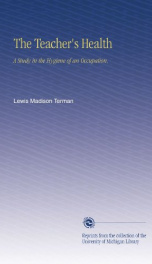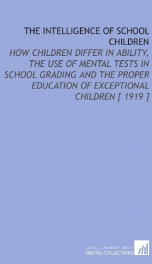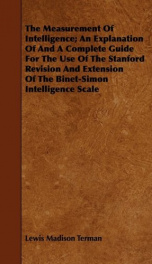Terman Lewis Madison

Lewis Madison Terman (15 January 1877 in Johnson County, Indiana – 21 December 1956 in Palo Alto, California) was an American psychologist, noted as a pioneer in educational psychology in the early 20th century at Stanford University. He is best known as the inventor of the Stanford-Binet IQ test. He was a prominent eugenicist and was a member of the Human Betterment Foundation. He was also served as president of the American Psychological Association. Terman received a B.S., B.Pd. (Bachelor of Pedagogy), and B.A. from Central Normal College in 1894 and 1898, and a B.A. and M.A. from the Indiana University Bloomington in 1903. He received his Ph.D. from Clark University in 1905. He worked as a school principal in San Bernardino, California in 1905, and as a professor at Los Angeles Normal School in 1907. In 1910 he joined the faculty of Stanford University as a professor of educational psychology at the invitation of Ellwood Patterson Cubberley and remained associated with the university until his death. He served as chairman of the psychology department from 1922 to 1945. During World War I, Terman served in the United States military while conducting psychological tests. Terman was able to work with other applied psychologists to categorise army recruits. The recruits were given group intelligence tests which took about an hour to administer. The examiners scored the tests on a scale ranging from "A" through "E". Recruits who earned scores of "A" would be trained as officers while those who earned scores of "D" and "E" would never receive officer training. The work of psychologists during the war proved to Americans that intelligence tests could have broader utility. After the war Terman and his colleages pressed for intelligence tests to be used in schools to improve the effieciency of growing American schools. Terman's initial studies were even more troublesome. He administered English tests to Spanish-speakers and unschooled African-Americans, concluding: “High-grade or border-line deficiency… is very, very common among Spanish-Indian and Mexican families of the Southwest and also among negroes. Their dullness seems to be racial, or at least inherent in the family stocks from which they come… Children of this group should be segregated into separate classes… They cannot master abstractions but they can often be made into efficient workers… from a eugenic point of view they constitute a grave problem because of their unusually prolific breeding” (The Measurement of Intelligence, 1916, p. 91-92). Terman's biased tests gave "scientific" proof that, for many Whites, justified racial discrimination, segregation, and eugenics. Unlike Binet and Simon, whose goal was to identify less able school children in order to aid them with the needed care required, Terman proposed using IQ tests to classify children and put them on the appropriate job-track. He believed IQ was inherited and was the strongest predictor of one's ultimate success in life. Terman adopted William Stern's suggestion that mental age/chronological age times 100 (to get rid of the decimal) be made the intelligence quotient or IQ. (NB: Most modern IQ tests calculate the intelligence quotient differently.) In 1921, Terman initiated the Genetic Studies of Genius, a long-term study of gifted children. He found that gifted children did not fit the existing stereotypes often associated with them: they were not weak and sickly social misfits, but in fact were generally taller, in better health, better developed physically, and better adapted socially than other children. The children included in his studies were colloquially referred to as "Termites."[1] Terman later joined the Human Betterment Foundation, a Pasadena-based eugenics group founded by E.S. Gosney in 1928 which had as part of its agenda the promotion and enforcement of compulsory sterilization laws in California. [http://www.terman.pausd.org/ Terman Middle School] in Palo Alto, California is named after himself and his son. Lewis Terman was the father of Frederick Terman, who, as provost of Stanford University, greatly expanded the science, statistics and engineering departments that helped catapult Stanford into the ranks of the world's first class educational institutions, as well as spurring the growth of Silicon Valley. Stanford University has an endowed professorship in his honor. Holders have included
do you like this author?
What readers are saying
What do you think? Write your own comment on this book!
write a commentWhat readers are saying
What do you think? Write your own comment on this author!
write a commentBook list

The Measurement of IntelligenceAn Explanation of and a Complete Guide for the Use of theStanford Revision and Extension of the Binet-SimonIntelligence Scale
Series:
Unknown
Year:
Unknown
Raiting:
4/5
Show more
add to favoritesadd In favorites

the teachers health a study in the hygiene of an occupation
Series:
Unknown
Year:
Unknown
Raiting:
5/5
This volume is produced from digital images created through the University of Michigan University Library's preservation reformatting program. The Library seeks to preserve the intellectual content of items in a manner that facilitates and promotes a variety of uses. The digital reformatting process results in an electronic version of the text that can both be accessed online and used to create new print copies. This book and thousands of others can be found in the digital collections of the University of Michigan Library. The University Library also understands and values the utility of print, and makes reprints available through its Scholarly Publishing Office.
Show more
add to favoritesadd In favorites

the intelligence of school children how children differ in ability the use of
Series:
Unknown
Year:
Unknown
Raiting:
3/5
Originally published in 1919. This volume from the Cornell University Library's print collections was scanned on an APT BookScan and converted to JPG 2000 format by Kirtas Technologies. All titles scanned cover to cover and pages may include marks notations and other marginalia present in the original volume.
Show more
add to favoritesadd In favorites
Book list

The Measurement of IntelligenceAn Explanation of and a Complete Guide for the Use of theStanford Revision and Extension of the Binet-SimonIntelligence Scale
Series:
Unknown
Year:
Unknown
Raiting:
4/5
Show more
add to favoritesadd In favorites

the teachers health a study in the hygiene of an occupation
Series:
Unknown
Year:
Unknown
Raiting:
5/5
This volume is produced from digital images created through the University of Michigan University Library's preservation reformatting program. The Library seeks to preserve the intellectual content of items in a manner that facilitates and promotes a variety of uses. The digital reformatting process results in an electronic version of the text that can both be accessed online and used to create new print copies. This book and thousands of others can be found in the digital collections of the University of Michigan Library. The University Library also understands and values the utility of print, and makes reprints available through its Scholarly Publishing Office.
Show more
add to favoritesadd In favorites

the intelligence of school children how children differ in ability the use of
Series:
Unknown
Year:
Unknown
Raiting:
3/5
Originally published in 1919. This volume from the Cornell University Library's print collections was scanned on an APT BookScan and converted to JPG 2000 format by Kirtas Technologies. All titles scanned cover to cover and pages may include marks notations and other marginalia present in the original volume.
Show more
add to favoritesadd In favorites

the hygiene of the school child
Series:
Unknown
Year:
Unknown
Raiting:
4.5/5
Originally published in 1914. This volume from the Cornell University Library's print collections was scanned on an APT BookScan and converted to JPG 2000 format by Kirtas Technologies. All titles scanned cover to cover and pages may include marks notations and other marginalia present in the original volume.
Show more
add to favoritesadd In favorites

suggestions for the education and training of gifted children
Series:
Unknown
Year:
Unknown
Raiting:
3/5
Show more
add to favoritesadd In favorites

The Measurement of Intelligence
Series:
Unknown
Year:
Unknown
Raiting:
3/5
Many of the earliest books, particularly those dating back to the 1900s and before, are now extremely scarce and increasingly expensive. We are republishing these classic works in affordable, high quality, modern editions, using the original text and artwork.
Show more
add to favoritesadd In favorites
What readers are saying
What do you think? Write your own comment on this author!
write a commentif you like Terman Lewis Madison try:
readers also enjoyed
What readers are saying
What do you think? Write your own comment on this author!
write a commentGenre
if you like Terman Lewis Madison try:
readers also enjoyed
Do you want to exchange books? It’s EASY!
Get registered and find other users who want to give their favourite books to good hands!

